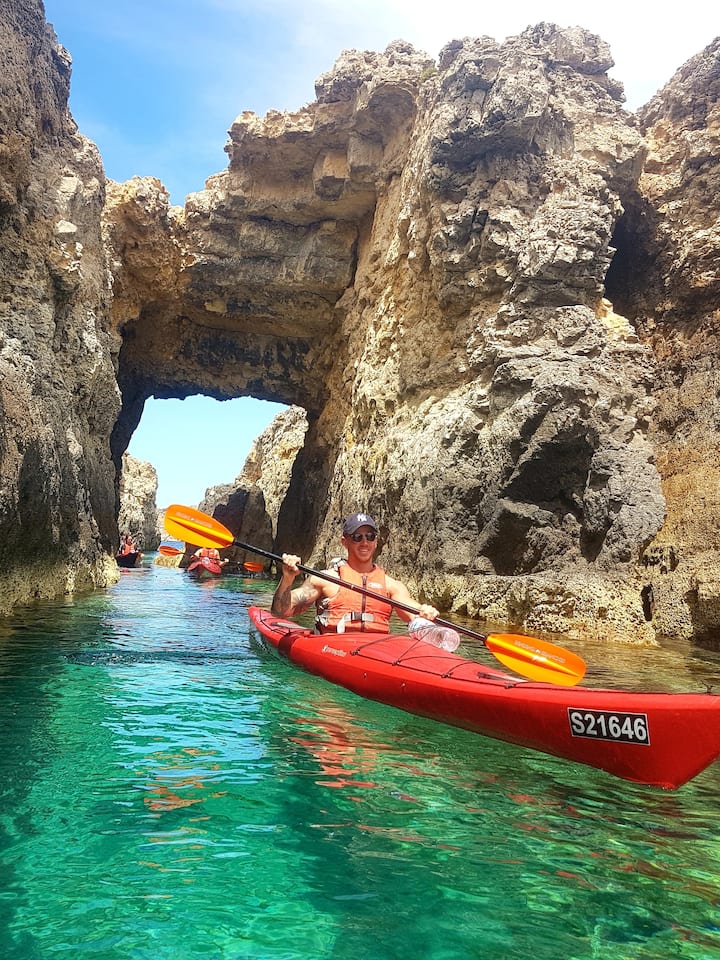野生動物
Ninu's Cave
36位當地人推薦、
當地人的貼士
To the rear of an ordinary house at No 15 January Street, ix-Xagħra is this natural cave discovered in 1888 by local resident Joseph Rapa. The cave, now well illuminated by electric lights, is remarkable for its plethora of natural stalactites and stalagmites. The cave is entered via a 4m descent down a flight of steps, which ends in a large chamber approximately 20 m by 8m. The calcification of water dripping from the cave ceiling has formed a forest of magnificent columns. There are even a few helictites (curved stalectites). Most of the formations are now dry and the same colour as the surrounding rock but some remain semitransparent and it is possible to see the rings formed as they grew.
To the rear of an ordinary house at No 15 January Street, ix-Xagħra is this natural cave discovered in 1888 by local resident Joseph Rapa. The cave, now well illuminated by electric lights, is remarkable for its plethora of natural stalactites and stalagmites. The cave is entered via a 4m descent do…
To the rear of an ordinary house at No 15 January Street, ix-Xagħra is this natural cave discovered in 1888 by local resident Joseph Rapa. The cave, now well illuminated by electric lights, is remarkable for its plethora of natural stalactites and stalagmites. The cave is entered via a 4m descent down a flight of steps, which ends in a large chamber approximately 20 m by 8m. The calcification of water dripping from the cave ceiling has formed a forest of magnificent columns. There are even a few helictites (curved stalectites). Most of the formations are now dry and the same colour as the surrounding rock.
To the rear of an ordinary house at No 15 January Street, ix-Xagħra is this natural cave discovered in 1888 by local resident Joseph Rapa. The cave, now well illuminated by electric lights, is remarkable for its plethora of natural stalactites and stalagmites. The cave is entered via a 4m descent do…
A four meter descent down a flight of stairs in an ordinary house on January Street in Xagħra, reveals a quirky discovery of stalactite and stalagmite formations in a cave. Ninu's cave was discovered in 1888 by Joseph Rapa who was digging for a well in the residence. Another similar remarkable discovery by Anthony Xerri took place a few years later in 1923, just a few streets away, in what is known today as Xerri's Grotto. Today, both caves are well illuminated and open to the public.
A four meter descent down a flight of stairs in an ordinary house on January Street in Xagħra, reveals a quirky discovery of stalactite and stalagmite formations in a cave. Ninu's cave was discovered in 1888 by Joseph Rapa who was digging for a well in the residence. Another similar remarkable disco…
Cave with stalagmites and stalactites discovered by accident during the construction of a private house !
To the rear of an ordinary house at No 15 January Street, ix-Xagħra is this natural cave discovered in 1888 by local resident Joseph Rapa. The cave, now well illuminated by electric lights, is remarkable for its plethora of natural stalactites and stalagmites. The cave is entered via a 4m descent down a flight of steps, which ends in a large chamber approximately 20 m by 8m. The calcification of water dripping from the cave ceiling has formed a forest of magnificent columns. There are even a few helictites (curved stalectites). Most of the formations are now dry and the same colour as the surrounding rock.
To the rear of an ordinary house at No 15 January Street, ix-Xagħra is this natural cave discovered in 1888 by local resident Joseph Rapa. The cave, now well illuminated by electric lights, is remarkable for its plethora of natural stalactites and stalagmites. The cave is entered via a 4m descent…
當地人都推薦
地點
Triq Jannar
Ix-Xagħra







